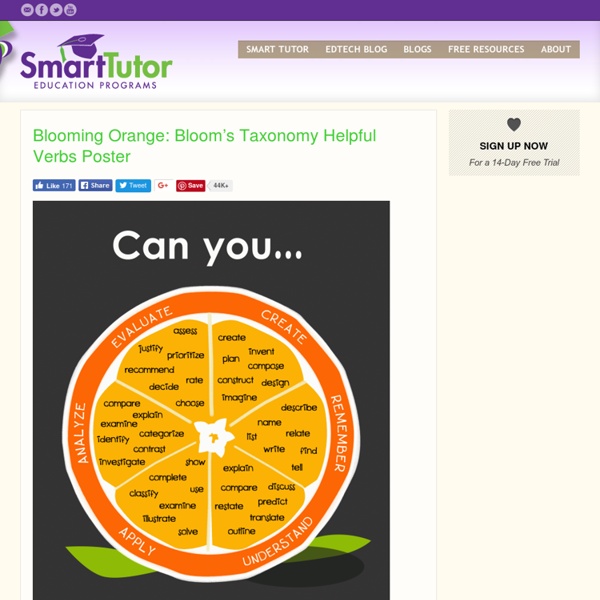Bloom’s Taxonomy Poster for Elementary Teachers
[Updated Nov 9, 2009 - Thanks for the feedback everyone! A special thanks to Mr. Portman & Ms. Quirk for their additional comments. Mr.
How to do Blackout Poetry and "Unstuck" Giveaway
For this week's giveaway I want to introduce you to a book called "Unstuck" by Noah Scalin. I was sent a copy to review by Quarry Books and I am truly amazed by this book. You can check out his website "Make Something 365".
Revised Bloom’s Taxonomy – CELT
Jump to the Bloom's Revised Taxonomy Model Go to the Flash version of the Bloom's Revised Taxonomy Model Download the PDF Version A statement of a learning objective contains a verb (an action) and an object (usually a noun). The verb generally refers to [actions associated with] the intended cognitive process.
Bloom's Digital Taxonomy Verbs [Infographic]
When using Bloom’s Digital Taxonomy (a revised take on Bloom’s devised by educator Andrew Churches), it helps to have a list of verbs to know what actions define each stage of the taxonomy. This is useful for lesson planning, rubric making, and any other teacher-oriented task requiring planning and assessment strategies. The Bloom’s Digital Taxonomy verbs in this handy infographic apply specifically to each stage of the taxonomy. They progress from LOTS (lower-order thinking skills) to the HOTS (higher-order thinking skills). According to Churches on his wiki Edorigami, “Bloom’s Revised Taxonomy describes many traditional classroom practices, behaviours and actions, but does not account for the new processes and actions associated with Web 2.0 technologies …” This means the verbs listed below are applicable to facilitating technology use in the modern classrooms. A Quick Reference Tool for Bloom’s Taxonomy Verbs
Bloom’s Taxonomy
Print Version by Patricia Armstrong, former Assistant Director, Center for Teaching Background Information | The Original Taxonomy | The Revised Taxonomy | Why Use Bloom’s Taxonomy? | Further Information
Bloom's Taxonomy
Mary Forehand The University of Georgia Introduction One of the basic questions facing educators has always been "Where do we begin in seeking to improve human thinking?" (Houghton, 2004). Fortunately we do not have to begin from scratch in searching for answers to this complicated question. The Communities Resolving Our Problems (C.R.O.P.) recommends, "One place to begin is in defining the nature of thinking.
The 5 C’s of Passion Driven Leadership
“Passion is one of the most powerful engines of success. When you do a thing, do it with all your might. Put your whole soul into it. Stamp it with your own personality. Be active, be energetic and faithful, and you will accomplish your object. Nothing great was ever achieved without passion.”
249 Bloom's Taxonomy Verbs For Critical Thinking
249 Bloom’s Taxonomy Verbs For Critical Thinking by TeachThought Staff Bloom’s Taxonomy’s verbs–also know as power verbs or thinking verbs–are extraordinarily powerful instructional planning tools.
249 Bloom's Taxonomy Verbs For Critical Thinking
249 Bloom’s Taxonomy Verbs For Critical Thinking by TeachThought Staff Bloom’s Taxonomy’s verbs–also know as power verbs or thinking verbs–are extraordinarily powerful instructional planning tools. In fact, next to the concept of backwards-design and power standards, they are likely the most useful tool a teacher-as-learning-designer has access to.
20 Of The Best Study Apps For The Plugged-In Student -
20 Of The Best Study Apps For The Plugged-In Student by TeachThought Staff Teaching and learning through technology is a complex thing. Learning what, from whom, and why?
Kathy Schrock's Guide to Everything - Bloomin' Apps
This page gathers all of the Bloomin' Apps projects in one place.Each image has clickable hotspots and includes suggestions for iPad, Android, Google and online tools and applications to support each of the levels of Bloom's Revised Taxonomy.I have created a page to allow you to share your favorite online tool, iOS, or Android app with others. Cogs of the Cognitive Processes I began to think about the triangular shape of Bloom's Taxonomy and realized I thought of it a bit differently.Since the cognitive processes are meant to be used when necessary, and any learner goes in and out of the each level as they acquire new content and turn it into knowledge, I created a different type of image that showcased my thoughts about Bloom's more meaningfully.Here is my visual which showcases the interlocking nature of the cognitive processes or, simply, the "Cogs of the Cognitive Processes". IPAD APPS TO SUPPORT BLOOM'S REVISED TAXONOMYassembled by Kathy Schrock Bloom's and SAMR: My thoughts
ICTyler
I attended the Digital Storytelling (K-12) Professional Development session at BU today. It was presented by Ron Nordstrom, Art Teacher and Technology Co-ordinator for Beautiful Plains SD. contains links and examples of all the things he went over in our session. Not only did we learn about various methods of digital storytelling, we got to play around with them too. He went over Audio Storytelling, Photostory, Comics and Online Scrapbooking One major focus was that whenever you use technology in the classroom you are to use it with a purpose. We are to judge the curricular outcomes and not the technology.
Smart Strategies for Student Success
Even students who’ve had years of active involvement in learning activities don’t automatically use strategies that best foster learning. However, working smarter through the use of specific success strategies can have a profound influence on learning outcomes. In this article, we share practical strategies teachers can use with students to help them learn smarter and with greater independence. Explain It to Your Brain



